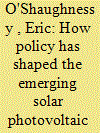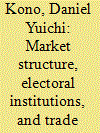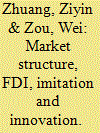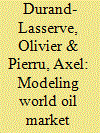|
|
|
Sort Order |
|
|
|
Items / Page
|
|
|
|
|
|
|
| Srl | Item |
| 1 |
ID:
178488


|
|
|
|
|
| Summary/Abstract |
Most literature on market competition in the banking industry neglects to address strategic interaction among banks. This paper studies interaction among Chinese banks by dividing banks into two groups: dominant banks (the “Big 5” state-owned banks) and small- and medium-sized banks (joint-stock banks and large city commercial banks). We test an oligopolistic model with conjectural variation developed by Spiller and Favaro (1984). Using data from 2007 to 2016, we find that banking competition is not in the form of Stackelberg competition per se. Some strategic interactions exist between small- and medium-sized banks and the largest state-owned bank. We also study the effect of interest rate deregulation on oligopolies' strategic interactions. Our results show that interest rate deregulation stimulates banking competition by reducing collusiveness among the dominant state-owned banks and enhancing the market power of small and medium banks.
|
|
|
|
|
|
|
|
|
|
|
|
|
|
|
|
| 2 |
ID:
153936


|
|
|
|
|
| Summary/Abstract |
Private military and security companies are integral components of the defense and intelligence operations of some of the world's most powerful states. Despite the increasingly pivotal role of contractors, analysts have yet to develop theories explaining when governments should outsource national security responsibilities or what conditions cause private defense markets to function efficiently. This inquiry addresses this gap in the literature by demonstrating that varying market structures—that is, the quantity of firms providing similar services and the number and purchasing power of those buying these services—have significant effects on costs, oversight, and company performance in the private defense industry. A principal–agent framework is developed to explain variation in the performance of firms in different markets across the industry. Evaluation of three private defense markets yields the surprising conclusion that monopsony, rather than a competitive market, is the ideal structure for governments outsourcing aspects of national defense.
|
|
|
|
|
|
|
|
|
|
|
|
|
|
|
|
| 3 |
ID:
174784


|
|
|
|
|
| Summary/Abstract |
China’s growing economic strength provides Beijing with potent instruments of economic statecraft to pursue political and strategic objectives. Yet studies of economic power and Chinese economic statecraft tend to concentrate on trade in goods, outbound investment, and international institutions. This article broadens this research program into trade in services by focusing on China’s outbound tourism sector. Drawing on a variety of Chinese and English language sources, the authors describe the history and structure of the domestic regulatory framework governing Chinese outbound tourism, before studying instances where the government has apparently intervened for strategic purposes. By unpacking how Chinese consumers arrange overseas holidays, this article provides insights into how the market structure of this service industry creates both opportunities for and constraints on China’s economic power.
|
|
|
|
|
|
|
|
|
|
|
|
|
|
|
|
| 4 |
ID:
076953


|
|
|
|
|
| Publication |
2007.
|
| Summary/Abstract |
This paper models the determination of the defence industrial base - the number of different military systems a country decides to maintain. High R&D costs means that few countries can afford to produce major weapons systems and the producers also import systems. Non-producers rely on imports and we assume their demand is driven by regional arms races. Military capability is determined by the number of systems and the quantity and quality of each. We examine how the defence industrial base is influenced by military expenditures, R&D costs, export controls, the nature of regional arms races and a variety of other factors.
|
|
|
|
|
|
|
|
|
|
|
|
|
|
|
|
| 5 |
ID:
104877


|
|
|
|
|
| Publication |
2011.
|
| Summary/Abstract |
In the context of energy sector reforms pursued by Romanian government since 1990s, we compare and contrast the market outcomes of European utilities' investment with the host government policy objectives. We begin with energy market reform in Romania and review governments' efforts to attract foreign direct investment (FDI) and to gradually withdraw from the distribution and supply segments of electricity market. Subsequently, we illustrate the scope European utilities have had, market policy and design notwithstanding, for consolidating market power through regional dominance. We examine the extent to which these utilities have sought to enhance their positions through horizontal and vertical integration, counter to the EU plans for a competitive market structure. We find that the investments of European incumbents have not been resoundingly successful: although market entrance may have been justified on long-term strategic grounds, in the immediate term, segments acquired through competitive auctions have yielded modest regulated returns. Finally, we discuss the extent to which policy makers have achieved their goals. Although the short-term benefits of a competitive market structure have reached some consumers, a renewed interest in promoting 'national champions' reflect frustration with market mechanisms as a means of ensuring long-term strategic investments in the sector.
|
|
|
|
|
|
|
|
|
|
|
|
|
|
|
|
| 6 |
ID:
183605


|
|
|
|
|
| Summary/Abstract |
Hundreds of state and local policies support the deployment of residential-scale solar photovoltaic systems in the United States. Policy differences across jurisdictions may explain differences in local photovoltaic industries, such as the number of competing installers, the distribution of market shares among those installers, and the market shares of large national-scale installers in local markets. This paper explores this hypothesis through a novel econometric model, the results of which suggest that various state and local policies indeed shape emerging photovoltaic industries. The results suggest that policies that generate higher customer electricity cost savings yield markets with more installers while higher levels of up-front photovoltaic subsidies produce markets with fewer installers. Further, both up-front subsidies and ongoing incentives yield markets where national-scale installers hold less market share. These results indicate that policies have long-term indirect impacts on photovoltaic markets by shaping nascent installation industries. Policymakers could use the results to identify and design policies that help raise infant installation industries to maturity.
|
|
|
|
|
|
|
|
|
|
|
|
|
|
|
|
| 7 |
ID:
128836


|
|
|
|
|
| Publication |
2014.
|
| Summary/Abstract |
This paper uses an output-oriented stochastic distance function to compute defense contractors' technical efficiency as a measure of performance. Then, nesting a market structure and conduct equation into the frontier, we identify firm and industry factors that affect the observed inefficiency levels. The empirical results confirm that there exist multi-directional causal correlations among market structure, conduct, and performance of defense contractors. In addition, the paper shows that there exists a great variability among the different sectors that compose the defense industrial base. Therefore, policies oriented to influence the industry must take into account the multi-directional causal relation among its components.
|
|
|
|
|
|
|
|
|
|
|
|
|
|
|
|
| 8 |
ID:
092334


|
|
|
|
|
| Publication |
2009.
|
| Summary/Abstract |
The view that intra-industry trade is politically easier to liberalize than inter-industry trade is widely held and potentially explains key features of the global trading system. This view, however, rests on weak theoretical and empirical foundations. I argue that intra-industry trade can in fact lead to higher protection, but only where electoral institutions privilege narrow protectionist interests. I support this hypothesis with an analysis of trade barriers in 4,400 sectors in 65 countries and an analysis of lobbying in the US. My results imply that scholars should stop invoking intra-industry trade as an explanation for low trade barriers in wealthy countries and advanced manufacturing sectors. They also have important implications for the more general relationship between political institutions, collective action, and policy outcomes.
|
|
|
|
|
|
|
|
|
|
|
|
|
|
|
|
| 9 |
ID:
100258


|
|
|
|
|
| Publication |
2010.
|
| Summary/Abstract |
We develop an extended North-South model to analyse the US-China IPRs conflict and possible policies. In our model, innovation in the North (US), imitation in the South (China), and Foreign Direct Investment (FDI) are all endogenous. We predict that whether tighter IPRs benefit the US or China depends crucially on market structure. In an oligopoly market induced by vertical innovation, tighter IPRs hurt both economies; while, in a monopolistic competition market induced by horizontal innovation, tighter IPRs benefit both economies as long as the degree of IPRs is appropriately chosen. We prove the existence of an optimal degree of IPRs protection in China, which may differentiate it from that in the US.
|
|
|
|
|
|
|
|
|
|
|
|
|
|
|
|
| 10 |
ID:
181771


|
|
|
|
|
| Summary/Abstract |
The choice of a modeling approach is driven by the oil policy or market question that needs to be addressed. We provide the non-modeling community with insightful information on oil market models, shedding light on the economic interpretation of technical aspects (such as the meaning of the costs associated with certain types of constraints), but without introducing any mathematical formulations. We also emphasize the reasonings and assumptions underlying the modeling structures and solutions proposed in the literature. We first review how models have usually represented market fundamentals. We then examine recent modeling developments addressing market issues (such as the impact of the shale oil revolution and the shift in producers’ behavior) and policy questions (such as the use of spare capacity to stabilize prices, the lifting of export controls, and the management of uncertainties surrounding the energy transition) that have emerged since the Great Recession. Moreover, given that climate policies increase the interdependency of all energy markets, we discuss how long-term multi-fuel models produce scenarios for oil as part of the global energy mix. We also suggest ways to tackle questions not yet covered by the oil market modeling literature, such as the dependence of government budgets on oil revenues.
|
|
|
|
|
|
|
|
|
|
|
|
|
|
|
|
| 11 |
ID:
150729


|
|
|
|
|
| Summary/Abstract |
The German market has seen a plunge in wholesale electricity prices from 2007 until 2014, with base futures prices dropping by more than 40%. This is frequently attributed to the unexpected high increase in renewable power generation. Using a parsimonious fundamental model, we determine the respective impact of supply and demand shocks on electricity futures prices. The used methodology is based on a piecewise linear approximation of the supply stack and time-varying price-inelastic demand. This parsimonious model is able to replicate electricity futures prices and discover non-linear dependencies in futures price formation. We show that emission prices have a higher impact on power prices than renewable penetration. Changes in renewables, demand and installed capacities turn out to be similarly important for explaining the decrease in operation margins of conventional power plants. We thus argue for the establishment of an independent authority to stabilize emission prices.
|
|
|
|
|
|
|
|
|
|
|
|
|
|
|
|
| 12 |
ID:
133269


|
|
|
|
|
| Publication |
2014.
|
| Summary/Abstract |
This study adds to the understanding of China's innovation prospects by examining how variations in institutional quality within China impact on the R&D efforts of firms located in different provincial regions. In the process of identifying the effect of institutional quality, the roles of other factors such as ownership types and market structures are revealed, which provides interesting insight into firms' R&D behavior. The key findings suggest that institutional quality positively affects the decision of firms to engage in R&D activities. Once firms start to engage in R&D, the subsequent expansion of firm-level R&D intensity depends on factors such as market structure. Therefore, strengthening domestic institutional quality is the first critical step towards the goal of building a knowledge-intensive economy in China. Efforts to nurture market development are also important for achieving this goal.
|
|
|
|
|
|
|
|
|
|
|
|
|
|
|
|
|
|
|
|
|